Eulalia Pérez de Guillén Mariné
| Eulalia Pérez de Guillén Mariné | |
|---|---|
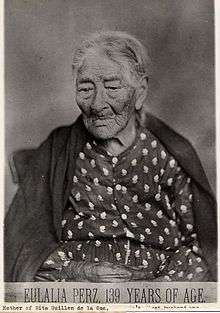 | |
| Born |
Eulalia Pérez Cotes (also Cota) 1766 Loreto, Baja California |
| Died |
June 11, 1878 (aged 112) Los Angeles, California |
| Occupation | Mayordoma |
| Spouse(s) |
Miguel Antonio de Guillén Juan Mariné (1833-1836) |
| Children | Maria Rita de Guillen de la Ossa, Maria del Rosario de Guillen White (Blanco), numerous other children |
| Parent(s) |
Diego Pérez Antonia Rosalía Cotes (or Cota) |
Eulalia Pérez de Guillén Mariné (1766 – June 11, 1878) was a Californio who was mayordoma of Missión San Gabriel Arcángel and grantee of Rancho del Rincón de San Pascual in the San Rafael Hills, in present-day Los Angeles County, California. She claimed to have been born in 1766, if so making her 112 years old at the time of her death in 1878, but her case has not been verified or fully proven.
Life
Early years
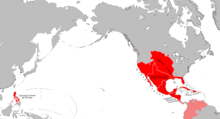
Eulalia Pérez was born in Loreto, the capital on the Baja California Peninsula of the Las Californias Province in the Viceroyalty of New Spain (in what is today the modern Mexican state of Baja California Sur), to Diego Pérez of Salamanca, Spain and Antonia Rosalia Cotes (or Cota). Macedonio Gonzalez, one of Eulalia's nephews, knew Antonia Cota as Lucia Valenzuela according to Eulalia's English born son-in-law and author Michael C. White, aka: Miguel Blanco.[1] Diego Pérez was a ship captain, thought to come from Salamanca—family members have been unable to trace records of his commission through the Archivo General de Indias or in Loreto, which has been ravaged by hurricanes over the centuries.[2] Her siblings were Teresa, Petra, Juana, Josefa, Bernardo, and León.
According to family lore, Capitan Pérez taught his daughter how to read and write, a fact later important to her survival and eventual prominence.[2] She married Spanish army Sergeant Miguel Antonio Guillén at age fifteen. He was in the company at the Presidio of San Diego. They moved from Baja about 1800 —on foot in those days— to the garrison at the new Mission San Gabriel, with their children Petra, Rosaria, and Isidoro. Miguel died while later serving at the garrison at San Diego, leaving Pérez with several children.
Missión San Gabriel
Pérez managed to obtain employment at Missión San Gabriel, initially as cook and midwife for those such as Governor Pío Pico.[1][2] She was eventually made "keeper of the keys" (mayor doma) of the missión itself.[2]
Rancho del Rincon del San Pascual
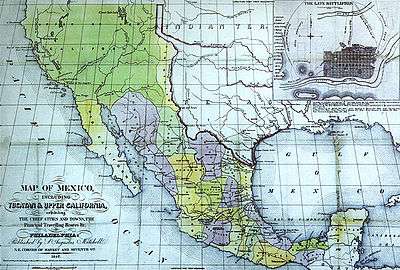
When she retired, Mexican Governor José Figueroa rewarded Pérez as the grantee of 14,402-acre (58.28 km2) Rancho del Rincón de San Pascual with her husband Juan Mariné.[3][4] Rancho San Pascual encompasses the present day cities of Pasadena, South Pasadena, and San Marino.[5] This had been part of the homeland of the Tongva-Gabrieleño Native Americans for thousands of years. Within the independent Mexican territory of Alta California, as a woman Pérez was unable to have ownership of property in her own name, so she married retired Mexican artillery lieutenant Juan Mariné (d. 1836).[6] (According to descendants, the fathers at San Gabriel Mission made her the grant under Spanish rule; when Mexico acquired Alta California, Pérez then married Juan Marine because Mexican law did not allow women to own land.[2])
According to some descendants, Mariné and his sons lost all the land in a short time by gambling.[2] In another narrative, one of Marine's sons, Fruto, was an active soldier and could not take charge of the Rancho. He sold it to José Pérez and Enrique Sepúlveda in 1839. Perez and Sepúlveda submitted a new land claim and in 1839 were re-granted their own title to Rancho San Pascual by Mexican Governor Juan Bautista Alvarado. Both built small adobe houses near the Arroyo Seco. Jose Perez died in 1841 and Enrique Sepulveda died in 1843, which left Rancho San Pascual abandoned until a new grantee later that year.
Flores Adobe - South Pasadena
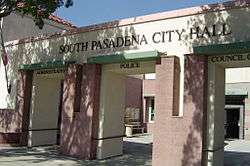
Pérez lived in the Adobe Flores, the 1839 adobe headquarters of Juan Perez on Rancho San Pascual on the southern slope of Raymond Hill. It was restored by architect Carleton Winslow, Sr. in the early 20th century and is still standing on Foothill Street in South Pasadena, and is on the National Register of Historic Places. It was named after a Californio hero, General Jose Maria Flores, the commander of the Mexican forces in Alta California during the Mexican-American War, who had camped near the adobe.[7]
She spent many years of her remaining life in the homes of various daughters, including that of Maria Rita de Guillén de la Ossa, wife of Jose Vicente de la Ossa, owner of Rancho de los Encinos, foundation of Encino, California. (What remains of that 100-acre (0.40 km2) rancho is now Los Encinos State Historic Park.[3][8][9])
Centenarian
Pérez died in the Los Angeles area on Jun 11, 1878. Her death certificate, located in the Santa Ana courthouse records that she lived to be 140, but descendants for the most part agree on more conservative figures like 110 or 112 years old,[2] making her a famous centenarian of early California and of U.S. history.[1] Eulalia Pérez de Guillén Mariné is one of only two non-clergy buried with the priests in the San Gabriel Mission courtyard cemetery. Although there is an unknown number of Native Americans from the Kizh tribe or Gabrielino (as they were later identified due to their proximity to the Mission) in the courtyard cemetery, the priests were buried in a designated section immediately adjacent to the wall of the Mission in a place of honor. In Catholic tradition, burials closest to the most sacred areas of the church are reserved for individuals of stature, usually clergy. Eulalia being honored in this way (Thomas Workman-Temple II, Mission Historian being the other), was a highly unusual honor at that time for a woman: a marble bench inscribed with her name marks the spot.[10] Her numerous descendants married other Californios from other founding Spanish and Mexican families of pre-statehood California.[1]
See also
Descendants
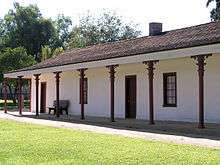
Some of Eulalia Perez de Guillen Marine's (deceased) descendants include:
- Maria Rita de Guillen de la Ossa, wife of Don Jose Vicente de la Ossa, owners of Rancho de los Encinos in Encino, Los Angeles, California
- Maria Manuela de la Ossa Thompson
- Susanna de la Ossa
- Antonio Maria Fulgencio de la Ossa Sr.
- Antonio Maria Fulgencio de la Ossa Jr.
- Fabricio de la Ossa
- Constancia de la Ossa Kevane
- Katherine Kevane Murray, champion of English for Spanish-speaking children in California public schools
- Alexander Howison Murray, Jr. (1907-1993), twice mayor of Placerville, California
- Patricia Murray Chambers (1936-2007) of Frederick, Maryland (obituaries: Washington Post, Frederick News Post, Placerville Mountain Democrat)
- Katherine Murray Boultinghouse (daughter of Katherine Kevane Murray), close designer of Los Angeles, California
- Constance Murray Raffetto (daughter of Katherine Kevane Murray), sculptress of Berkeley, California, and wife of radio actor Michael Raffetto
- Alexander Howison Murray, Jr. (1907-1993), twice mayor of Placerville, California
- Katherine Kevane Murray, champion of English for Spanish-speaking children in California public schools
- Jose Vicente de la Ossa Jr.
- Pablo de la Ossa
- Clotilde de la Ossa
- David de la Ossa
- Manuel Henninger (1896-1964), son of David de la Ossa and Louisa Henninger; David and Louisa never married so her children, Manuel, Elvira (b.1892) and Pablo (b.1899), took her surname. Louisa Henninger is the daughter of William Kimber Henninger, a miner and settler of Henninger Flats in the Angeles National Forest of the San Gabriel Mountains and Teresa Serrano, a San Diego Mission Indian.[11]
- Maria Elvira "Billie" Henninger (b. 1929), wife of Edward Frank Jeffredo (b. 1926), Edward is a descendant of Juan Matias Sanchez, owner of Rancho La Merced, located in modern day Montebello, CA. The Juan Matias Sanchez adobe still stands and is a registered City of Montebello Historic Landmark.[12][13]
- Manuel Henninger (1896-1964), son of David de la Ossa and Louisa Henninger; David and Louisa never married so her children, Manuel, Elvira (b.1892) and Pablo (b.1899), took her surname. Louisa Henninger is the daughter of William Kimber Henninger, a miner and settler of Henninger Flats in the Angeles National Forest of the San Gabriel Mountains and Teresa Serrano, a San Diego Mission Indian.[11]
- Leonora de la Ossa Durfee
- Maclovia de la Ossa
- Carlos de la Ossa
- Florestina de la Ossa Gilbert - (186?-1955) (Somos Primos obituary)
- Maria del Rosario de Guillen Blanco/White (d. 1892), wife of Michael White (AKA Miguel Blanco)
- Juana Paula White Courtney (b. 1833)
- Jaime Courtney
- Soila Esperanza Courtney Alvarado (1879-1949)
- Beatrice Margaret Alvarado White (1899-1966)
- Jaime Courtney
- Esther White Castillon
- Margaret Castillon Cota
- Francesca White Heslop
- Maria Heslop Plaisance
- Joe Northrop (1918-2003), husband of California genealogical historian Mary E. Northrop
- Maria Heslop Plaisance
- Juana Paula White Courtney (b. 1833)
- Victoria Duarte Cordova (Great Great Granddaughter of Eulalia), California genealogist and historian, (1912-2005)[14]
- Beatrice Duarte Cuellar (Great Great Granddaughter of Eulalia and sister to Victoria Duarte Cordova) (1911-1965)
- Barbara Cuellar Kuppens (Daughter of Beatrice Cuellar) (1930-2012)
References
- 1 2 3 4 White, Michael C. (1956). "California all the way back to 1828". G. Dawson. OCLC 1883045. Retrieved December 30, 2009.
- 1 2 3 4 5 6 7 Chambers, David. "Eulalia Perez de Guillen Marine". David Chambers. Retrieved December 30, 2009.
- 1 2 Kielbasa, John R. (1998). "Flores Adobe". Historic Adobes of Los Angeles County. Pittsburg: Dorrance Publishing Co. ISBN 0-8059-4172-X. .
- ↑ http://www.laokay.com/halac/FloresAdobe.htm laokay: Rancho San Pascual history . accessed 8/20/2010
- ↑ "California Ranchos by County". California Weekly Explorer. Archived from the original on 2007-05-21. Retrieved 2007-05-25.
- ↑ Aileen Fish Underwood (2006-04-25). "Los Angeles Area Timeline". CaGenWeb. Archived from the original on 2007-01-28. Retrieved 2007-05-25.
- ↑ Rasmussen, Cecilia (March 11, 2007). "At Flores Adobe, history stands solid". Los Angeles Times. Retrieved April 29, 2009.
- ↑ Los Encinos Docents Association. "Los Encinos State Historic Park". State of California. Retrieved 2007-05-25.
- ↑ KCET. "Life and Times, episode on Los Encinos, first aired October 10, 2007". KCET. Retrieved 2007-10-12.
- ↑ "Eulalia Perez Guillen". Find A Grave. Retrieved 2007-05-25.
- ↑ "Henninger Flats". Wikipedia. 2017-03-31.
- ↑ "Rancho La Merced". Wikipedia. 2016-12-04.
- ↑ "Juan Matias Sanchez Southern California Ranchero". juanmatiassanchez.com. Retrieved 2018-01-05.
- ↑ "Settlers' Descendant Works to Keep Past Alive". Los Angeles Times. 29 August 1990. Retrieved 9 October 2016.
External sources
- "Una vieja y sus recuerdos dictados ... a la edad avanzada de 139 años". San Gabriel, CA: Calisphere of University of California. 1877. Retrieved 9 October 2016.
- "The Reminiscences of Eulalia Pérez" in The Californians, The Magazine of California History (Grizzly Publications).
- Tales of California Yesterday by Rose L. Ellerbe (Los Angeles: Warren T. Potter, 1916), "Three Cooks of San Gabriel," pp. 11–17
- J. Michael Walker: All the Saints of the City of the Angels (Berkeley: HeyDay Books, 2008), pp. 142-145, 197
- Latinos in Pasadena by Roberta H. Martinez (San Francisco: Aradia Publishing, 2009), pp. 16-18, 25, 28, 30, 34
- Latina Legacies: Identity, Biography, and Community by Vicki Ruíz and Virginia Sánchez Korrol (New York: Oxford University Press, 2005), pp. 24-25
- White, Michael C.; Savage, Thomas (1956). California all the way back to 1828. Los Angeles: G. Dawson. OCLC 1883045.
- Híjar, Carlos; Pérez, E.; Escobar, A.; Savage, T. (1988). Three memoirs of Mexican California. Berkeley, CA: University of California, Berkeley. OCLC 18444155.
- In America by Susan Sontag (New York: Macmillan, 2001), p. 193.
- Uppity Women of the New World by Vicki Leon (Newburyport, MA: Conari, 2001), pp. 60-61
- Lindley, Walter; Joseph Pomery Widney (1888). California of the South: Its Geography, Climate, Resources, Routes of Travel, and Health-Resorts being a complete guide-book to Southern California (1888). New York: D. Appleton and Company.
- Native Daughters of the Golden West: Doña Eulalia Pérez DeGuillén - California Pioneer Project
- Michael White Adobe website - (research section: information on Eulalia Pérez
- "Eulalia Pérez - chapter in the diary of son-in-law Michael White—Miguel Blanco
(published as California all the way back to 1828 By Michael C. White, written by Thomas Savage for the Bancroft Library (1877), introduction and notes by Glen Dawson, illustrated by Clarence Ellsworth) - California History Quarterly: Eulalia Pérez de Guillén - 52:71-75; 53:141
- National Genealogical Society Quarterly: California's Centenarian: Eulalia Pérez de Guillén - June 1962, Volume 50 Number 2
- UC Berkeley News: California women's "Collective Voice" exhibit
- Los Angeles Times: "At Flores Adobe, history stands solid" - March 11, 2007
- Homestead Museum blogsite - March 4, 2010
- Raven Jake - October 7, 2009
- Pasadena Hoy (Spanish version) - October 2, 2008
Photos
- Eulalia Pérez: mother of Rita De La Ossa - The De La Ossa Family Photograph Collection
- Santa Clara University: Eulalia Perez
- UC Berkeley News: Exhibit's slideshow]
- Homestead Museum: Eulalia Perez de Guillen Marine circa 1878